Drawing comparisons between studies is difficult
Aquaculture feeds are generally formulated to meet production goals such as efficient feed conversion and fast growth, but the fat composition of feeds can also influence processing yield, health benefits, and fish flavor.
Fats have a major impact on dietary energy content, which affects the deposition of visceral fat and consequent processing yield. Health benefits for those who consume fish are largely a reflection of the omega-3 fatty acids composition of feeds. Omega-3 fatty acids have been shown to offer protection from hypertension, myocardial infarction, and atherosclerotic heart disease.
Undesirable “fishy” flavor can be caused by oxidation of highly unsaturated fats. As aquaculture nutrition advances, feeds must not only deliver high productivity, but end-product characteristics required by processors and final consumers, as well.
Farmed vs. wild fish
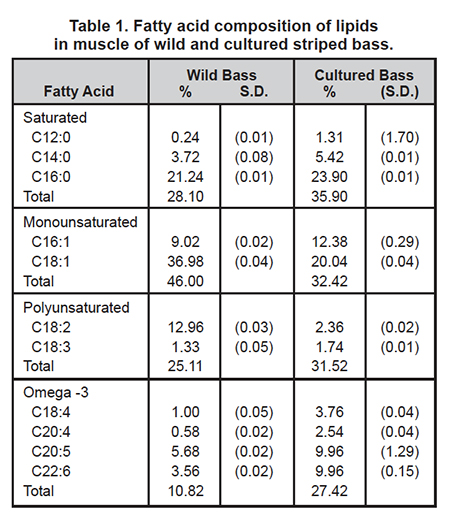 Several studies comparing the lipid differences between farmed and wild fish have been reported, but there has been no standard format for reporting such information. Therefore, drawing comparisons between different studies is not always possible.
Several studies comparing the lipid differences between farmed and wild fish have been reported, but there has been no standard format for reporting such information. Therefore, drawing comparisons between different studies is not always possible.
The difference in lipid composition between wild and cultured fish appears to depend on fish species and feed composition. A lipid analysis between wild and cultured striped bass showed that cultured fish contained a greater concentration of saturated fatty acids and less monounsaturated fatty acids (Table 1), but the polyunsaturated fatty acid content exhibited little variation.
Surprisingly, the sum of omega-3 fatty acids was almost 300 percent greater in the cultured fish. However, another study on fatty acid profiles of lipids indicated that wild fish had substantially higher concentrations of omega-3 and lower levels of omega-6 fatty acids than aquacultured fish.
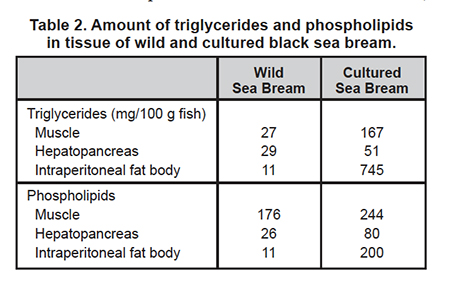 This is not surprising, because commercial aquaculture feeds are generally supplemented with vegetable oils that contain higher concentrations of omega-6 fatty acids than typical diets consumed in the wild. The accumulation of dietary lipids in the edible muscle tissue would account in part for the observed fatty acids distribution.
This is not surprising, because commercial aquaculture feeds are generally supplemented with vegetable oils that contain higher concentrations of omega-6 fatty acids than typical diets consumed in the wild. The accumulation of dietary lipids in the edible muscle tissue would account in part for the observed fatty acids distribution.
Comparing lipid composition
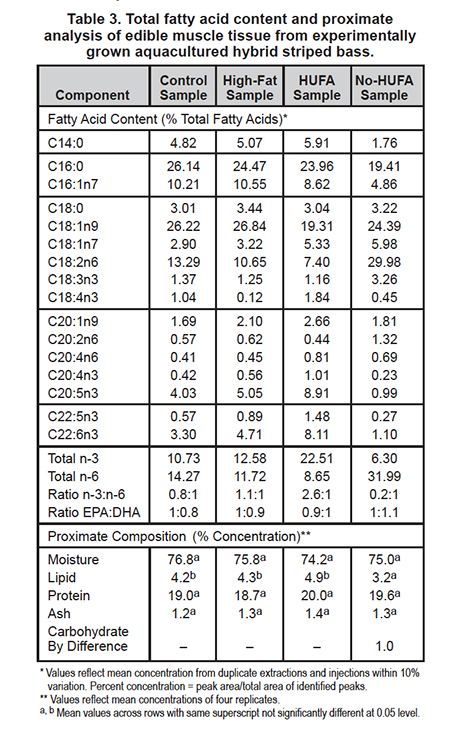 A comparison of lipid class composition of muscle, liver, and intraperitoneal fat composition between cultured and wild black sea bream showed a greater quantity of triglycerides (36 percent compared to 12 percent) in the cultured fish contained than the wild. However, the cholesterol content was similar. The phospholipid content, important in the diet for the physical properties of membranes, was approximately 25 percent higher in the wild fish.
A comparison of lipid class composition of muscle, liver, and intraperitoneal fat composition between cultured and wild black sea bream showed a greater quantity of triglycerides (36 percent compared to 12 percent) in the cultured fish contained than the wild. However, the cholesterol content was similar. The phospholipid content, important in the diet for the physical properties of membranes, was approximately 25 percent higher in the wild fish.
The difference in lipid composition between the fish can be better observed when the results are compared on an equal weight basis (Table 2), rather than the percent of total lipid content. The lipid content is substantially greater in the cultured fish.
A reasonable argument could be made that because of this difference, the cultured fish should be considered a different species or as a subspecies. The results also indicate some diet components, perhaps the most expensive ones, are being utilized in a less-useful portion of the fish.
A lipid analysis of cultured and wild horse mackerel showed less-striking differences than were exhibited in the sea bream and striped bass Performed over four months, the analysis found most lipid contents in the cultured fish were higher than in the wild fish. The greatest differences occurred in the 20-carbon chain fatty acids.
Feed and lipids
The effect of feed composition on the lipid fraction in the edible muscle of hybrid striped bass can be observed in Table 3. Fish fed diets high in omega-3 fatty acids contained over 100 percent more of those fatty acids.
A sensory panel indicated the fish fed the diet without highly unsaturated fatty acids (HUFA) were significantly less “fishy” that those fed the HUFA-containing diet. Although eicosapentaenoic (EPA) and docosahexaenoic acid (DHA) do not exhibit fish flavors and aromas, their oxidation products are known contributors to strong fish flavors and aromas. Sensory panels have noted that fish fillets with substantially lower concentrations of EPA and DHA exhibit fewer fishy flavors.
Conclusion
Lipid concentrations in fish depend on species and diet composition. Also, diet directly affects fillet yields and therefore profitability. Selective breeding of fish should consider composition from the perspective of human nutrition, as well as production cost and consumer preferences for flavor and aroma.
These aspects should be included in any long-term plan for fish breeding if producers are to introduce products with appeal for consumers. Also, information on fish composition should contain a detailed diet composition that includes the omega-3 content. Research results should be standardized to permit meaningful comparisons. Failure to provide detailed diet information and utilize standardized reporting reduces the value of available composition analyses.
(Editor’s Note: This article was originally published in the August 2002 print edition of the Global Aquaculture Advocate.)
Now that you've reached the end of the article ...
… please consider supporting GSA’s mission to advance responsible seafood practices through education, advocacy and third-party assurances. The Advocate aims to document the evolution of responsible seafood practices and share the expansive knowledge of our vast network of contributors.
By becoming a Global Seafood Alliance member, you’re ensuring that all of the pre-competitive work we do through member benefits, resources and events can continue. Individual membership costs just $50 a year.
Not a GSA member? Join us.
Author
-

George J. Flick, Jr., Ph.D.
Food Science and Technology Department
Virginia Tech (0418)
Blacksburg, Virginia 24061 USA
Tagged With
Related Posts
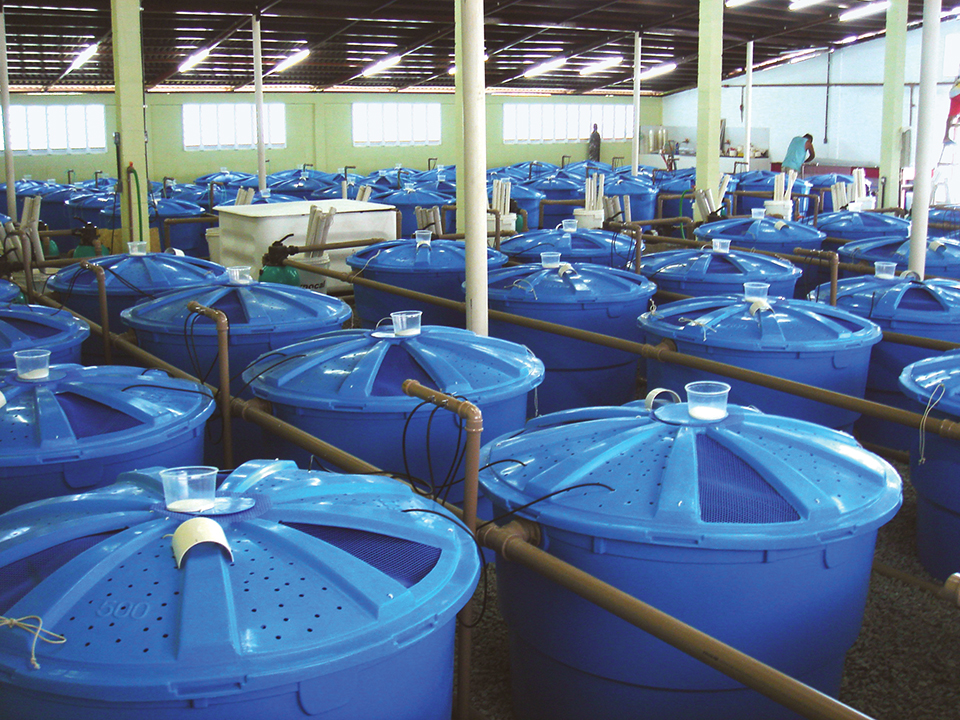
Health & Welfare
Fatty acids in feeds improve growth, lipid profiles of white shrimp farmed at high salinity
A study showed that lipid source and DHA and EPA levels in feeds can influence the growth performance and tail fatty acid profiles of L. vannamei farmed under hypersaline conditions.
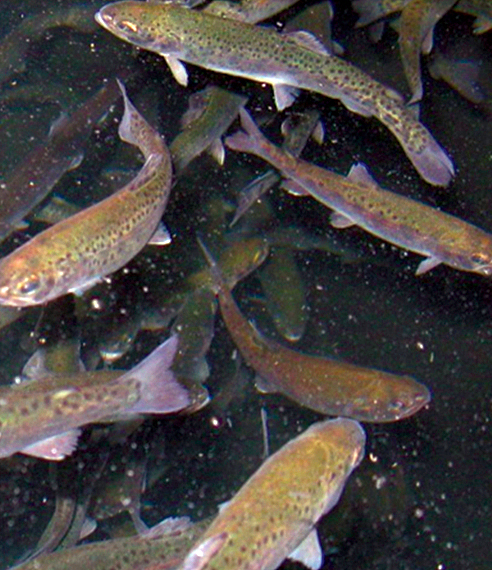
Aquafeeds
Alternative lipids spare fish oil in rainbow trout feeds
Alternative lipids have achieved varied success in ensuring adequate growth and fatty acid composition in fillets. The authors evaluated rainbow trout raised on diets containing fish oil or a blend of fish and standard or modified lipids varying in fatty acid composition.
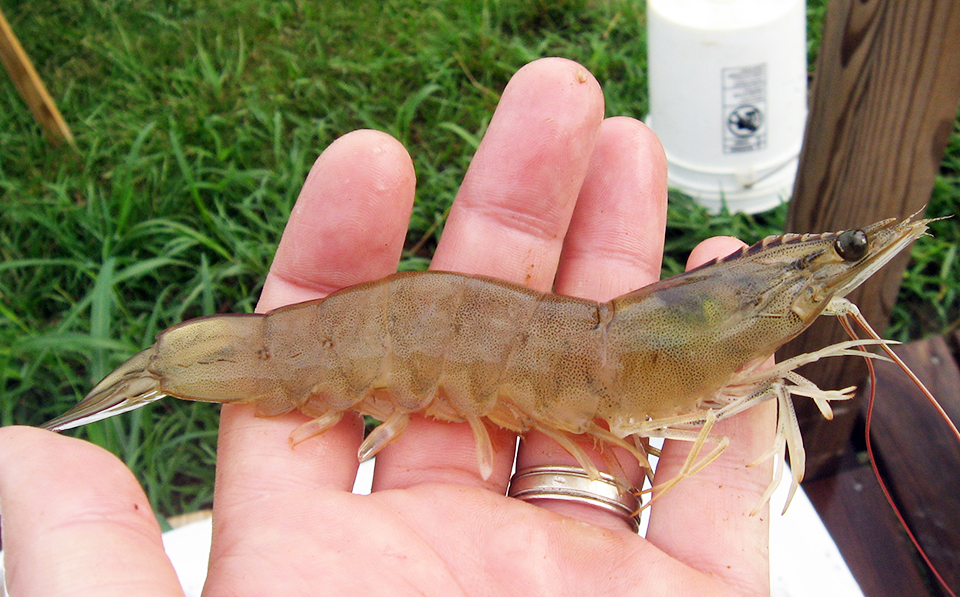
Aquafeeds
Alternatives to fishmeal perform well in low-salinity shrimp farm trial
In a white shrimp farm trial in a low-salinity environment, alternatives to fishmeal did not negatively impact the growth, survival or FCR of the shrimp.
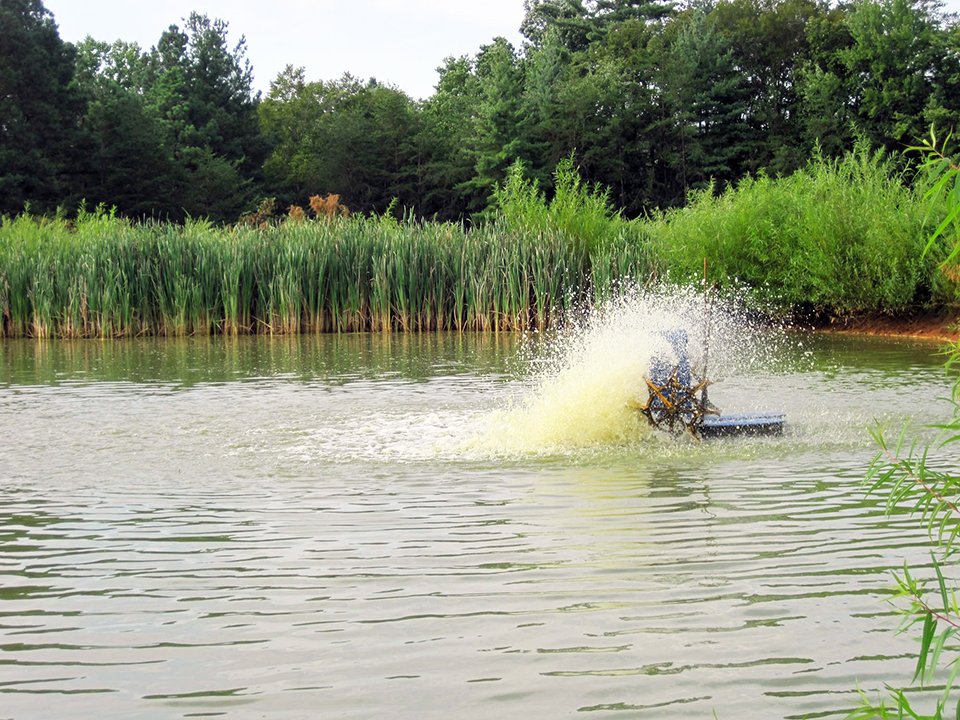
Responsibility
Biofloc technology options for aquaculture
Biofloc technology offers advantages for the sustainable culture of shrimp and some species of fish.

